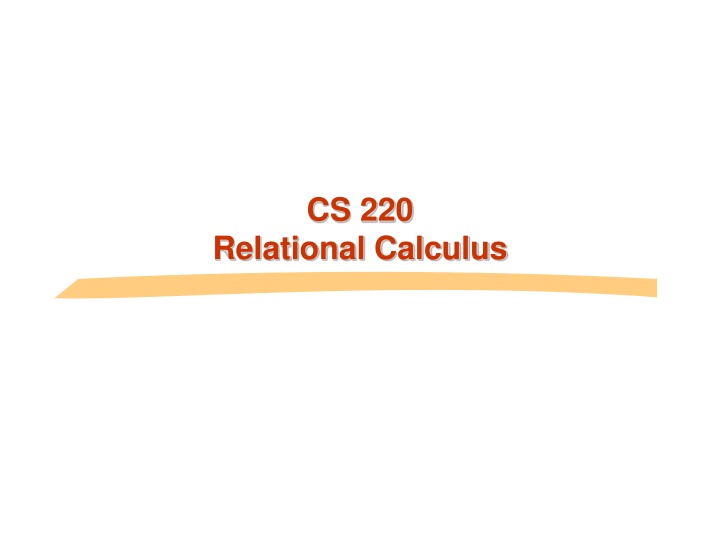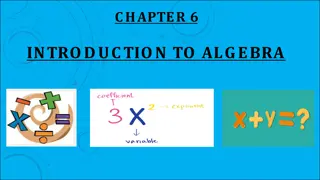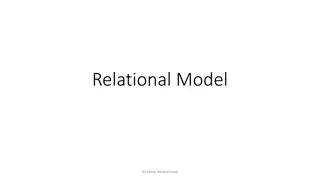Introduction to Relational Calculus and Algebra in Database Management
Explore the fundamental concepts of relational calculus and algebra in the domain of database management. Understand the differences between declarative and imperative query languages and learn to retrieve information using practical examples and theoretical frameworks such as tuple relational calculus and domain relational calculus.
Download Presentation

Please find below an Image/Link to download the presentation.
The content on the website is provided AS IS for your information and personal use only. It may not be sold, licensed, or shared on other websites without obtaining consent from the author.If you encounter any issues during the download, it is possible that the publisher has removed the file from their server.
You are allowed to download the files provided on this website for personal or commercial use, subject to the condition that they are used lawfully. All files are the property of their respective owners.
The content on the website is provided AS IS for your information and personal use only. It may not be sold, licensed, or shared on other websites without obtaining consent from the author.
E N D
Presentation Transcript
CS 220 Relational Calculus
Attendance Quiz: Relational Algebra Name each of these relational algebra operations and briefly describe what they do: , , , , , , , , , * Use these operations to form these queries: 1. Retrieve the names of all employees 2. Retrieve the name of the employee with SSN = 123456789 3. Retrieve the names of the employees with SSN = 123456789 or SSN = 234567891 4. Retrieve the name of each manager and the name of the department they manage 5. Retrieve the names of each department with an office in Houston 6. Retrieve the names and SSNs of the employees making more than $71,000 Employee Full_Name John Smith Jane Smith Franklin Wong SSN 123456789 234567891 345678912 Salary 70000 71000 72000 Department Name Research Administration ID 1 2 Mgr_SSN 345678912 234567891 D_Locations D_ID 1 1 2 Location Houston Boston Boston
Today you will learn How to retrieve information from a relational schema using a declarative language In contrast, the relational algebra is imperative
Relational Query Languages Query = retrieval program Language examples: Theoretical: 1. Relational Algebra 2. Relational Calculus a. tuple relational calculus (TRC) b. domain relational calculus (DRC) Practical 1. SQL (SEQUEL from System R) 2. QUEL (Ingres) 3. Datalog (Prolog-like) Theoretical QL s: give semantics to practical QL s key to understand query optimization in relational DBMSs
Chapter 8 Outline Unary Relational Operations: SELECT and PROJECT Relational Algebra Operations from Set Theory Binary Relational Operations: JOIN and DIVISION Additional Relational Operations Examples of Queries in Relational Algebra The Tuple Relational Calculus The Domain Relational Calculus
The Tuple Relational Calculus Relational Calculus Specify what you want, not how to get it (i.e, declarative, not procedural) Relational algebra Specify how to get the information you want (i.e, procedural) However Any retrieval that can be specified in basic relational algebra can also be specified in relational calculus! We are getting closer to SQL
Tuple Variables and Range Relations Tuple variable: t Satisfy: COND(t) Specify: Range relation R of t What tables are you interested in? Select particular combinations of tuples What filtering rules do you want to apply? Set of attributes to be retrieved (requested attributes) What attributes are you interested in?
Expressions and Formulas in Tuple Relational Calculus General expression of tuple relational calculus is of the form: Truth value of an atom Evaluates to either TRUE or FALSE for a specific combination of tuples Formula (Boolean condition) Made up of one or more atoms connected via logical operators AND, OR, and NOT
Three Forms of Atoms R(ti) Range relation: used to show which table(s) tuples you are interested in Example: EMPLOYEE(t) ti.A {=, <, , >, , } c Filters the tuples Example: t.first_name = Smith ti.A {=, <, , >, , } tj.B Filters the tuples Example: t.first_name = t.last_name
COMPANY Database EMPLOYEE Fname Minit Lname Ssn Bdate Address Sex Salary Super_ssn Dno DEPARTMENT Dname Dnumber Mgr_ssn Mgr_start_date DEPT_LOCATIONS Dnumber Dlocation PROJECT Pname Pnumber Plocation Dnum WORKS_ON Essn Pno Hours DEPENDENT Essn Dependent_name Sex Bdate Relationship
Existential and Universal Quantifiers Universal quantifier: ( t)(F) TRUE when F is TRUE for every t Existential quantifier ( t)(F) TRUE when F is TRUE for at least one t Possible to transform between each other: Negation (preceded by NOT) AND and OR replace one another A negated formula becomes unnegated, and vice-versa For example:
Queries Using Quantifiers Quantifiers are needed for multi-table queries Variable d is bound to the existential quantifier Whereas t is free (i.e., not bound to a quantifier) All free variables should appear to the left of the bar Bound variables shouldn't appear to the left of the bar
Safe Expressions Guaranteed to yield a finite number of tuples as its result Otherwise expression is called unsafe Which is safe? {t | NOT EMPLOYEE(t)} {t | EMPLOYEE(t)}
The Domain Relational Calculus Differs from tuple calculus in type of variables used in formulas Variables range over single values from domains of attributes You won t see it on the homework, exams, etc., but you should know it exists SQL: Based on Tuple Relational Calculus QBE (Query-By-Example): Based on Domain Relational Calculus
The Domain Relational Calculus (contd.) Or using QBE-style shorthand: We won't use the Domain Relational Calculus in this course!
Formal Languages for Relational Model Relational algebra Imperative: specify how to get what you want Tuple/domain relational calculus Declarative: specify what you want Possible to convert queries between the two























